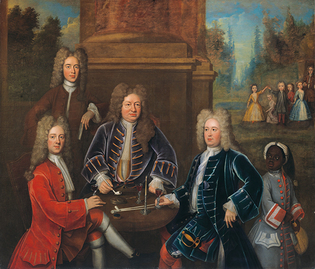
Yale Center for British Art
This group portrait, featuring Elihu Yale (who holds a long-stemmed pipe), includes one very young enslaved child.
View full image
A child, enslaved
While the group of children in the background of this painting are shown joyfully at play, another child in the foreground brings wine to the seated men. To judge from the painting, he is ten years old, probably about the same age as the boy in the background also wearing a grey coat and red stockings. Like many other depictions of people of African descent in British portraits of this period, the boy’s identity has been largely ignored. The collar on his neck is of a type seen in at least 50 other paintings made in Britain between 1660 and 1760.
The painting, previously titled Elihu Yale; William Cavendish, the second Duke of Devonshire; Lord James Cavendish; Mr. Tunstal; and an Enslaved Servant, is in the collection of the Yale Center for British Art and now on display. Earlier this year, for the first time in its history, the painting was subject to a thorough technical study, bringing to light new information that corrects longstanding assumptions about what the painting depicts, which in turn have implications for the child’s biography. The discovery of the pigment Prussian Blue—invented in Germany in 1709 and arriving in Britain the following decade—provided a pivotal piece of evidence for redating and rethinking this group portrait.
Such portraits are a stark reminder of Britain’s entrenchment in the transatlantic slave trade, which by the beginning of the nineteenth century had seen over two and a half million people ensnared from the west coast of Africa and sold into chattel slavery. These depictions also point specifically to the invidious practice in the seventeenth and eighteenth centuries of bringing children to Britain to serve as domestic servants in the households of the elite.
Chattel slavery was ostensibly unlawful within Britain’s shoreline. But as these portraits show, this did not stop thousands of Black children and adults from being brought to Britain over the course of the seventeenth and eighteen centuries, in an ill-defined but often violently enforced state of what modern writers have characterized as “slavish servitude.” Collars made of silver, steel, or brass, of the type seen in the painting, were not used to tether the wearer to other shackles but were impossible to divest from the body and served to deter self-emancipation.
Within the painting, the child not only works but performs another role: he moves from a below-stairs area to a rarefied patriarchal space, to fill the glasses of the three seated men. Here the central figure is Yale University’s namesake and early benefactor, Elihu Yale (1649–1721). We can be confident about the identities of Elihu Yale and James Cavendish—Yale’s son-in-law—because their likenesses match those in other portraits. The identities of the other sitters are less secure. Based on comparisons with other portraits, the seated man wearing blue is most likely Dudley North of Glenham Hall, Suffolk, who married Yale’s eldest daughter, Catherine. The children in the background are almost certainly Yale’s grandchildren.
What does this new information mean for our understanding of the identity and life of the enslaved child? The date of the painting can now be said to fall between around 1719 and 1721. Given the youthful appearance of the child, this suggests he was born in around 1710. It is likely that he was brought to England at around the age of five and presumably had been in the household of one of the seated men for three or four years. A thorough survey of the parish registers for the area in and around Elihu Yale’s London home in Queen Square reveals a small but significant Black presence in Bloomsbury in this period, but none of these individuals can be readily identified as the child in the painting.
It is possible that the child’s proximity to Dudley North in the painting indicates a tie between them. There was certainly a Black presence in the household of North’s wider family: From at least 1721 his cousin Francis North, the second Baron Guilford, had a servant named Francis Juba; he was described as “Black” at his baptism in London but was in fact from India. As a child, Juba served as a page and then remained a salaried member in the household of this other branch of the North family for close to two decades before being apprenticed to a barber and wig maker in London.
It is possible this child’s life took a path similar to that of Francis Juba. But it is equally possible that, like many other enslaved children and adults in Britain in the seventeenth and eighteenth centuries, he chose to run away. At present, we still don’t know what happened next in this child’s life.
Edward Town is the assistant curator of paintings and sculpture at the Yale Center for British Art.
 loading
loading